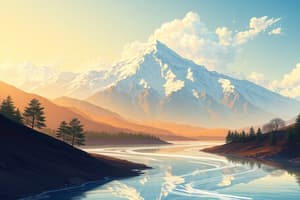Podcast
Questions and Answers
What accounts for the rain shadow effect observed on the leeward side of the Western Ghats?
What accounts for the rain shadow effect observed on the leeward side of the Western Ghats?
- The adiabatic warming of air as it descends, reducing its relative humidity and capacity to form precipitation. (correct)
- Deforestation on the leeward side, decreasing moisture retention in the soil and limiting rainfall.
- Increased solar radiation on the leeward side, leading to rapid evaporation and reduced precipitation.
- The convergence of prevailing winds on the leeward side, creating stable atmospheric conditions resistant to precipitation.
How does the interaction between the summer monsoon winds and the Himalayan mountain range influence rainfall patterns across India?
How does the interaction between the summer monsoon winds and the Himalayan mountain range influence rainfall patterns across India?
- The Himalayas have no significant impact on the monsoon winds or rainfall distribution in India.
- The Himalayas block the monsoon winds, causing uniform rainfall distribution across the country.
- The Himalayas act as a barrier, causing the monsoon winds to ascend, leading to orographic rainfall in the northern plains and foothills. (correct)
- The Himalayas divert the monsoon winds westward, resulting in decreased rainfall in eastern India.
How do the unique soil compositions found in different regions of India, such as black soil (Regur) and alluvial soil, primarily influence agricultural practices and crop yields?
How do the unique soil compositions found in different regions of India, such as black soil (Regur) and alluvial soil, primarily influence agricultural practices and crop yields?
- Soil type has minimal effect on agricultural practices due to modern irrigation and fertilization techniques.
- Alluvial soil's high clay content restricts root penetration, leading to lower crop yields compared to black soil.
- Black soil, with its high water retention, is ideal for cotton cultivation, while alluvial soil supports a wider range of crops due to its fertility. (correct)
- The nutrient content of both soil types is identical, resulting in similar crop selection and yields across regions.
What role do cyclones formed in the Bay of Bengal and the Arabian Sea play in influencing India's climate, and what factors determine their impact on different coastal regions?
What role do cyclones formed in the Bay of Bengal and the Arabian Sea play in influencing India's climate, and what factors determine their impact on different coastal regions?
How might climate change-induced glacial melt in the Himalayan region affect the hydrology and agricultural practices of the Indo-Gangetic Plain?
How might climate change-induced glacial melt in the Himalayan region affect the hydrology and agricultural practices of the Indo-Gangetic Plain?
Flashcards
Tectonic Location of India
Tectonic Location of India
India is located primarily on the Indian Plate, part of the Indo-Australian Plate, with some northern parts on the Eurasian Plate.
Himalayan Mountain Range
Himalayan Mountain Range
The Himalayas form India's northern border, acting as a natural barrier and influencing its climate and river systems.
Indo-Gangetic Plain
Indo-Gangetic Plain
The Indo-Gangetic Plain is a fertile region fed by the Indus and Ganges rivers, supporting a large population and agriculture.
Thar Desert
Thar Desert
Signup and view all the flashcards
Indian Coastline
Indian Coastline
Signup and view all the flashcards
Study Notes
- India is located in South Asia and is the seventh-largest country in the world by land area.
- It is the second most populous country, with over 1.3 billion people.
- India shares land borders with Pakistan to the west, China, Nepal, and Bhutan to the north-east, and Myanmar and Bangladesh to the east.
- In the Indian Ocean, India is in the vicinity of Sri Lanka and the Maldives; in addition, India's Andaman and Nicobar Islands share a maritime border with Thailand and Indonesia.
Major Geographical Features
- The Himalayas form the northern border, separating India from the rest of Asia.
- Key Himalayan ranges include the Greater Himalaya, Lesser Himalaya, and Outer Himalaya (Shivalik).
- The Indo-Gangetic Plain, a fertile and densely populated region, lies south of the Himalayas.
- The Thar Desert, also known as the Great Indian Desert, is located in the western part of India.
- The Peninsular Plateau is a stable landform in the southern part of India, characterized by hills and plateaus.
- The Indian coastline extends over 7,500 kilometers, including the mainland and island territories.
Climate
- India experiences a wide range of climate conditions, from tropical in the south to temperate and alpine in the Himalayan north.
- The Indian monsoon is a major influence on the climate, bringing significant rainfall to most parts of the country.
- The monsoon season typically lasts from June to September.
- Different regions experience different climatic conditions: hot and dry summers, cool and dry winters, and wet monsoons.
River Systems
- The Indus River system is one of the major river systems, although most of its course lies in Pakistan.
- The Ganges River is considered the most sacred river in India and is a crucial water source for a large population.
- The Brahmaputra River flows through northeastern India and is another major river system.
- Other important rivers include the Yamuna, Narmada, Godavari, Krishna, and Kaveri.
Natural Resources
- India is rich in various natural resources, including coal, iron ore, manganese, mica, bauxite, petroleum, and natural gas.
- The distribution of these resources is uneven, with some regions being richer than others.
- The country's mineral resources support various industries, including steel, aluminum, and energy.
Soil Types
- Alluvial soil is found in the Indo-Gangetic Plain and is highly fertile.
- Black soil, also known as regur soil, is found in parts of Maharashtra, Madhya Pradesh, and Gujarat and is suitable for cotton cultivation.
- Red soil is found in southern and eastern India and is less fertile compared to alluvial or black soil.
- Laterite soil is found in regions with high rainfall and is not very fertile.
Vegetation
- India has a diverse range of vegetation, from tropical rainforests to alpine forests.
- Tropical rainforests are found in the Western Ghats and northeastern India.
- Deciduous forests are widespread throughout the country.
- Thorn forests and scrublands are found in arid and semi-arid regions.
- Mangrove forests are found along the coastlines.
States and Territories
- India is divided into 28 states and 8 union territories.
- Each state has its own government, while union territories are governed by the central government.
- The states are further divided into districts and smaller administrative units.
Geographic Regions
- The Himalayas: Northern mountain range affecting climate and river systems.
- Indo-Gangetic Plain: Fertile plains, densely populated.
- Thar Desert: Arid region in western India.
- Peninsular Plateau: Tableland with mineral resources.
- Coastal Plains: East and west coasts with ports, fishing, and varied agriculture.
- Islands: Andaman and Nicobar, Lakshadweep, strategic and rich in biodiversity.
Importance of Geography
- The geography of India influences its climate, agriculture, and economy.
- The Himalayas act as a barrier, protecting India from cold winds and influencing rainfall patterns.
- The fertile plains support a large population and agricultural activities.
- The coastal regions are important for trade and commerce.
- Natural resources play a crucial role in industrial development.
Studying That Suits You
Use AI to generate personalized quizzes and flashcards to suit your learning preferences.




